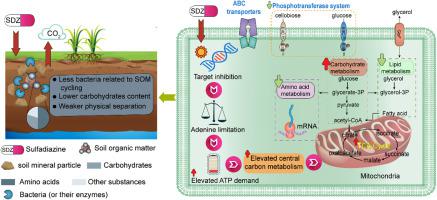Journal of Hazardous Materials ( IF 13.6 ) Pub Date : 2021-06-10 , DOI: 10.1016/j.jhazmat.2021.126388 Linlin Qiu 1 , Tim J Daniell 2 , Steven A Banwart 3 , Muhammad Nafees 1 , Jingjing Wu 1 , Wenchao Du 4 , Ying Yin 1 , Hongyan Guo 5

|
The accumulation of sulfonamides in the soil environment possessed the potential to change soil microbial community and function. Metabolomics is capable of providing insights into the carbon metabolic pool and molecular mechanisms associated with external stressors. Here we evaluated alternations in soil bacterial community and soil metabolites profiles under sulfadiazine (SDZ) exposure and proposed a potential mechanism that SDZ accumulation in soil affected soil organic matter (SOM) cycling. Sequencing analysis showed that the relative abundance of bacterial species associated with carbon cycling significantly decreased under high concentrations of SDZ exposure. Untargeted metabolomics analysis showed that 78 metabolites were significantly changed with the presence of SDZ in soil. The combination of functional predictions and pathway analysis both demonstrated that high concentrations of SDZ exposure could cause disturbance in anabolism and catabolism. Moreover, the noticeable decline in the relative content of carbohydrates under high concentrations of SDZ exposure might weaken physical separation and provide more chances for microbes to degrade SOM. The above results provided evidence that SDZ accumulation in soil held the potential to disturb SOM cycling. These findings spread our understanding about the environmental risk of antibiotic in the soil environment beyond the dissemination of antibiotic resistance.
中文翻译:

磺胺嘧啶干扰土壤微生物群落和功能机制的洞察
磺胺类物质在土壤环境中的积累具有改变土壤微生物群落和功能的潜力。代谢组学能够深入了解与外部压力源相关的碳代谢库和分子机制。在这里,我们评估了磺胺嘧啶 (SDZ) 暴露下土壤细菌群落和土壤代谢物谱的变化,并提出了土壤中 SDZ 积累影响土壤有机质 (SOM) 循环的潜在机制。测序分析表明,在高浓度 SDZ 暴露下,与碳循环相关的细菌种类的相对丰度显着降低。非靶向代谢组学分析表明,土壤中 SDZ 的存在显着改变了 78 种代谢物。功能预测和通路分析的结合都表明,高浓度的 SDZ 暴露可能会导致合成代谢和分解代谢紊乱。此外,在高浓度 SDZ 暴露下碳水化合物相对含量的显着下降可能会削弱物理分离并为微生物降解 SOM 提供更多机会。上述结果证明土壤中 SDZ 的积累具有干扰 SOM 循环的潜力。这些发现传播了我们对抗生素在土壤环境中的环境风险的理解,超越了抗生素耐药性的传播。在高浓度 SDZ 暴露下碳水化合物相对含量的显着下降可能会削弱物理分离并为微生物降解 SOM 提供更多机会。上述结果证明土壤中 SDZ 的积累具有干扰 SOM 循环的潜力。这些发现传播了我们对抗生素在土壤环境中的环境风险的理解,超越了抗生素耐药性的传播。在高浓度 SDZ 暴露下碳水化合物相对含量的显着下降可能会削弱物理分离并为微生物降解 SOM 提供更多机会。上述结果证明土壤中 SDZ 的积累具有干扰 SOM 循环的潜力。这些发现传播了我们对抗生素在土壤环境中的环境风险的理解,超越了抗生素耐药性的传播。



























 京公网安备 11010802027423号
京公网安备 11010802027423号